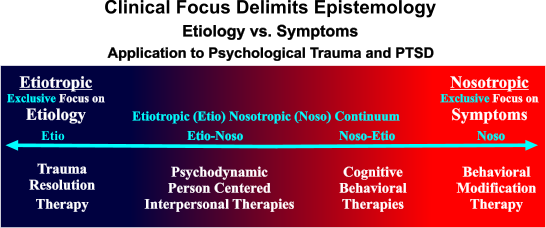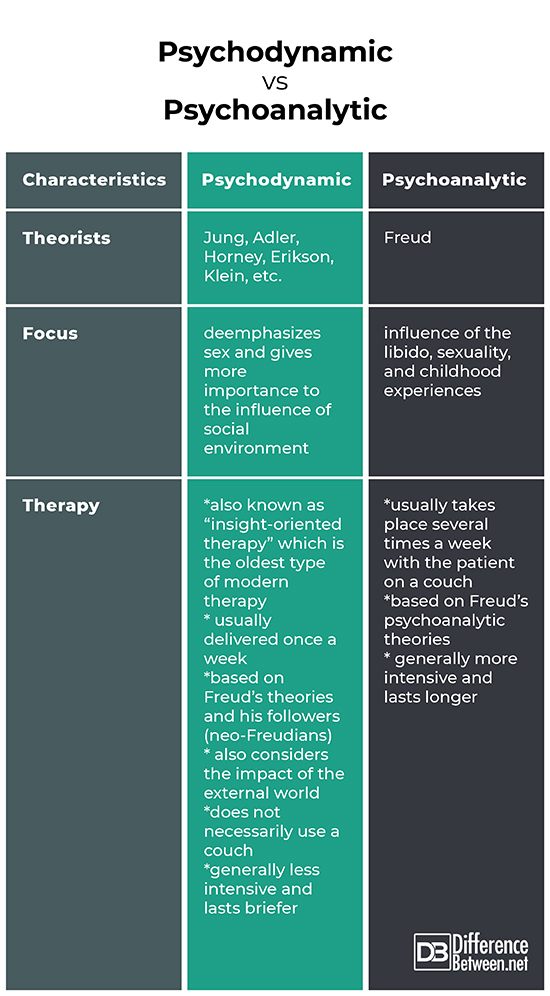What is the Difference Between Psychodynamic and Psychoanalytic?
Psychodynamic and psychoanalytic theories acknowledge the importance of unconscious psychological processes and childhood experiences. Both are also closely associated with Sigmund Freud, the founder of psychoanalysis. They expound on the manifestations of defense mechanisms, free association, dream analysis, inner conflicts, etc. Hence, a number of sources use these terms interchangeably. However, psychodynamic perspective covers the theories and approaches based on Freud and his followers (who may have later contradicted him) while psychoanalytic perspective specifically pertains to the original theories and therapeutic approach of Freud.

What is Psychodynamic?
Psychodynamic perspective refers to the therapeutic approach and theories developed by Freud and supported by his followers such as the neo-Freudians (though they disagreed with some of his concepts); they generally deemphasized sex and gave more importance to the influence of social environment. Some of them are:
Carl Jung
Jung was a Swiss psychiatrist who was Freud’s protégé. His theory is called “Analytical Psychology”; he met Freud in 1907, they were impressed with each other’s work and developed a close friendship. In fact, Freud viewed Jung as his intellectual heir. However, Jung broke away from Feud in 1913 due to their differing concepts. He thought that Freud’s theory of the unconscious was too negative and incomplete. For instance, Jung proposed that there was a deeper and transpersonal form of unconscious called the “collective unconscious” which is manifested by universal symbols. Freud then dismissed Jung’s interest in myths as being unscientific.
Alfred Adler
Adler was an Austrian psychiatrist, his theory is called “Individual Psychology”. He was the first president of the Vienna Psychoanalytical Society; hence, he was a part of Freud’s inner circle of colleagues. Instead of sexual and aggressive urges, Adler believed that we are driven by feelings of inferiority in childhood and that people should be studied as a whole. Because of his disagreements with Freud, Adler left the society, taking one third of the members with him.
Karen Horney
Horney was a German psychoanalyst who also questioned some of Freud’s theories. She is credited for her feminist psychology; Horney disagreed with Freud’s concept of “penis envy” ( young girls experience anxiety when they realize that they do not have a penis). She stated that men experience “womb envy”, that men are actually envious of women’s ability to bear children.
According to the American Psychological Association (2017), psychodynamic therapy is an in-depth form of talk therapy which is usually delivered once a week (and is usually briefer than the traditional psychoanalytic therapy). Aside from looking into the unconscious and past experiences, this approach also considers the impact of the external world. This is also known as “insight-oriented therapy” which is the oldest type of modern therapy (Embogama, 2016).

What is Psychoanalytic?
Psychoanalytic perspective refers to theories and therapeutic methods which are based on the original works of Freud, an Austrian neurologist. The term “psychoanalysis” was coined by Freud in 1896. His interest in the unconscious mind was spurred by the case of “Anna O.” who got cured when her repressed memories were uncovered (Ackerman, 2020). The basic assumptions of this approach include:
- Psychological problems are rooted in the unconscious.
- Treatments focus on bringing the repressed conflict to consciousness.
- Personality is largely influenced by childhood experiences.
- Individuals employ defense mechanisms against threatening information from the unconscious.
- The mind is composed of the id, ego, and superego.
- Dreams are the royal road to the unconscious.
- All tension is due to the increase of libido and that all pleasure is derived from its discharge.
Psychoanalytic therapy usually takes place several times a week with the patient on a couch (American Psychological Association, 2017). It is based on Freud’s psychoanalytic theories and is generally more intensive and lasts longer than psychodynamic therapy.
Difference between Psychodynamic and Psychoanalytic
Theorists
Psychoanalytic perspective refers to theories and therapeutic methods which are based on the original works of Freud, who coined the term “psychoanalysis” in 1896. On the other hand, psychodynamic perspective refers to the therapeutic approach and theories developed by Freud and supported by his followers such as the neo-Freudians (Jung, Adler, Horney, Erikson, Klein, etc.).
Focus
Psychodynamic perspective generally deemphasizes sex and gives more importance to the influence of social environment. On the contrary, the psychoanalytic perspective gives more importance to the influence of the libido.
Therapy
Psychodynamic therapy is an in-depth form of talk therapy which is usually delivered once a week (APA, 2017). Aside from looking into the unconscious and past experiences, this approach also considers the impact of the external world. This is also known as “insight-oriented therapy” which is the oldest type of modern therapy (Embogama, 2016). In comparison, psychoanalytic therapy usually takes place several times a week with the patient on a couch (APA, 2017). It is based on Freud’s psychoanalytic theories and is generally more intensive and lasts longer than psychodynamic therapy.
Psychodynamic vs Psychoanalytic

Summary
- Psychodynamic and psychoanalytic theories acknowledge the importance of unconscious psychological processes and childhood experiences.
- Psychodynamic perspective refers to the therapeutic approach and theories developed by Freud and supported by his followers such as the neo-Freudians.
- Psychoanalytic perspective refers to theories and therapeutic methods which are based on the original works of Freud.
- Psychodynamic perspective generally deemphasizes sex and gives more importance to the influence of social environment.
- As compared to psychoanalytic therapy, psychodynamic therapy is less intense and briefer. It also considers the impact of the external world and does not necessarily use the iconic couch.
- Difference Between Hematoma and Melanoma - February 9, 2023
- Difference Between Bruising and Necrosis - February 8, 2023
- Difference Between Brain Hematoma and Brain Hemorrhage - February 8, 2023
Search DifferenceBetween.net :
1 Comment
Leave a Response
References :
[0]Ackerman, C. (2020). Psychoanalysis: A brief history of Freud’s psychoanalytic theory. Positive Psychology. https://positivepsychology.com/psychoanalysis/
[1]American Psychological Association. (2017). Psychoanalysis vs. psychodynamic therapy. https://www.apa.org/monitor/2017/12/psychoanalysis-psychodynamic
[2]Image credit: https://commons.wikimedia.org/wiki/File:Personality_systematics.jpg
[3]Image credit: https://en.wikipedia.org/wiki/File:EtioNosoContinuum.png

Thank you Gene Brown for you explanation of What is the Difference Between Psychodynamic and Psychoanalytic?
What is the Difference Between Psychodynamic and Psychoanalytic? | Difference Between http://www.differencebetween.net/science/psychology/what-is-the-difference-between-psychodynamic-and-psychoanalytic/#ixzz7M3cXa951